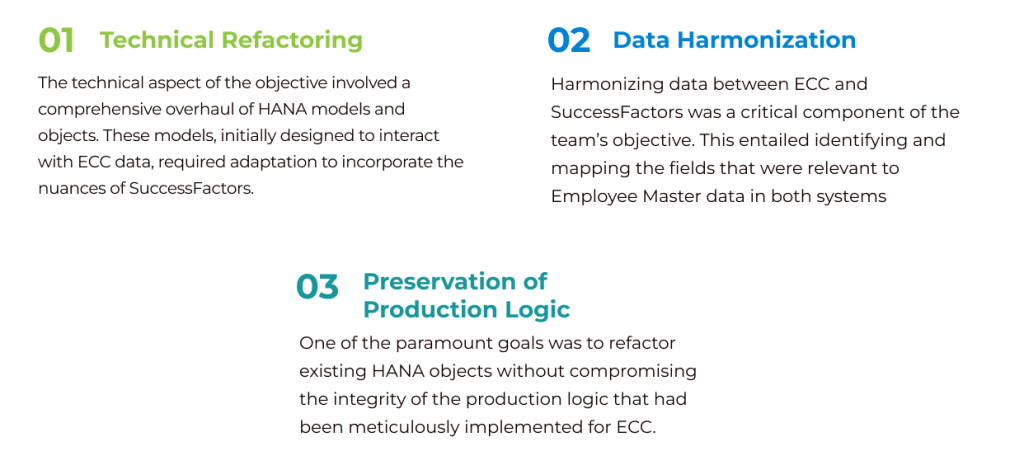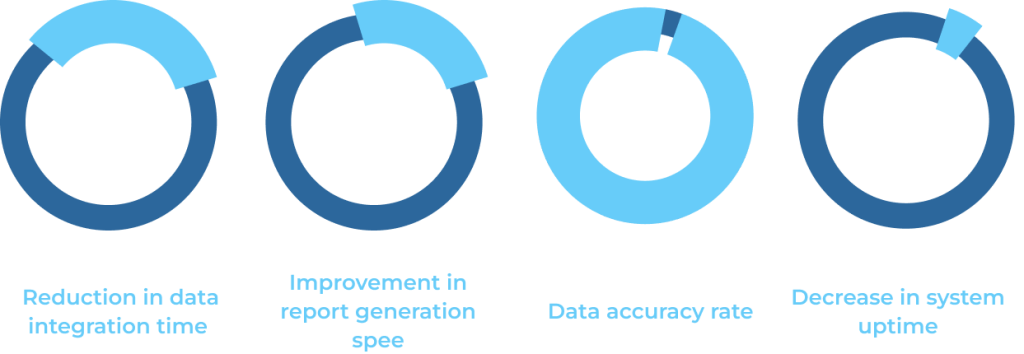The Fortune 500 service provider company, our client, aimed to improve their current ECC (Enterprise Central Component) system through a transition to SAP SuccessFactors, utilizing the expertise of LMTEQ. The collaboration between the client and our team in the HXM refactor project aimed to establish a unified data source for both the HR department and people master data. This case study explores the challenges encountered throughout the project, the strategic solutions implemented by our team to overcome obstacles, and ultimately, the impact of the project.
The overarching goal of this HXM reform project was to seamlessly transition from the existing SAP ECC system to SAP SuccessFactors, a robust cloud-based HR software. Our team’s objective here was to refactor all existing HANA models and objects that relied on employee master data from ECC, ensuring smooth integration with SuccessFactors. For better transition, the team divided objectives into small clusters to make sure that the project went smoothly.

Integrating analytic solutions into the ECC system in HANA, and accommodating SuccessFactors data through careful refactoring without compromising critical reports and applications was a big challenge.

Mapping fields between ECC and SuccessFactors for Employee Master data added complexity, requiring not only technical mapping but also ensuring the integrity and relevance of the data in the context of refactored HANA objects.
Refactoring HANA models and objects without disrupting the existing production logic posed a delicate challenge to the team.
A significant challenge arose from the need to support both ECC and Successfactors data simultaneously until the Successfactors Go-Live.
Through strategic refactoring of ECC system solutions in HANA, the team modified components for compatibility with both ECC and SuccessFactors data, ensuring the preservation of critical reports and applications.
To address field mapping challenges between ECC and SuccessFactors, the team mapped Employee Master data fields for unified data loading. SuccessFactors tables seamlessly accommodated both data sources, ensuring smooth integration into refactored HANA objects.
To minimize impact, the team carefully and phasely refactored HANA models, isolating areas for modification and mitigating risks to critical applications and reports.

A significant challenge arose from the need to support both ECC and Successfactors data simultaneously until the Successfactors Go-Live.
The HXM Refactor project yielded notable results, validating the effectiveness of the undertaken strategies and the successful navigation of challenges. Notably, the refactoring efforts led to a 20% reduction in data integration time, streamlining the process of consolidating both ECC and SuccessFactors data into unified tables.
This optimization translated into a 15% improvement in report generation speed, enhancing overall system performance. Furthermore, the project achieved a remarkable 99.5% data accuracy rate during testing, ensuring the reliability of critical HR applications and reports.
As a testament to the success of the dual-system support strategy, the transition to SuccessFactors resulted in minimal disruptions, with only a 2% decrease in system uptime during the entire Go-Live phase.

The comprehensive strategies employed to overcome challenges, particularly in Legacy Analytic Solutions and Dual System Support, have borne fruit. The meticulous mapping of fields, unified data loading, and incorporation of hybrid master data tables have not only facilitated a smooth transition from ECC to SuccessFactors but have also yielded tangible benefits. With our team’s plan and implementation, our client was able to achieve the goal of the project by having a unified data source for both the HR department and people master data.